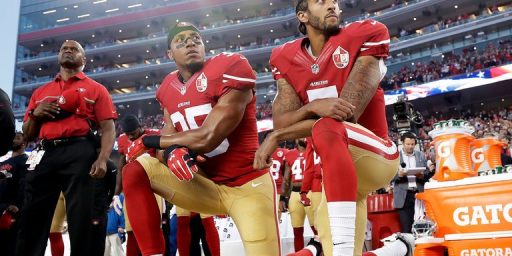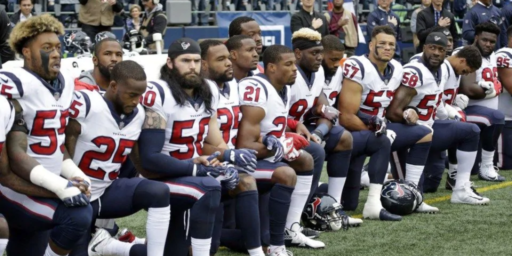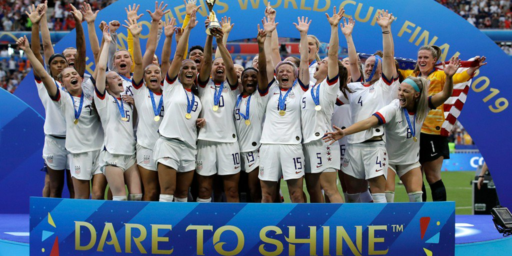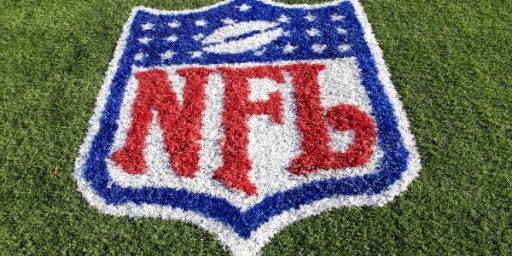NFL Labor Talks Break Off
The NFL may be about to go into labor chaos:
NFL owners voted unanimously Thursday to break off talks with the players’ union on a contract extension, leaving the current salary cap in place with the start of free agency looming – and possibly forcing the mass dumping of veterans. The owners, who met for 57 minutes Thursday morning, endorsed a recommendation by their management council executive committee to reject the union’s latest proposal. NFL commissioner Paul Tagliabue was expected to have a news conference later Thursday morning.
The breakdown of talks left intact, for now, a salary cap of $94.5 million. The two sides had hoped to add $10 million to $15 million to the 2006 salary cap. Without the additional room, some teams could be forced into wholesale cuts to get beneath the cap by midnight. Free agency starts Friday. “Without an agreement with the union on an extension, the league year will begin as scheduled at midnight Thursday under the current terms of the CBA,” the league said Wednesday in a statement.
Owners did not seem inclined to cut into the difference of 4 percentage points between the sides. New England owner Robert Kraft had suggested that Thursday morning’s meeting might be short, just enough time to rubber stamp the executive committee’s decision. One reason was that revenue sharing, a point of contention among the owners, was not on the agenda – at least not at the start. The union insists that is needed for agreement and some owners agree.
Hall of Fame NFL sportswriter Rick Gosselin implores both sides, “Let’s be reasonable instead of greedy.”
When the sides agreed to a salary cap beginning in the 1994 season, clubs were limited to a $34.6 million payroll. Since then, the NFL has added four teams, creating in excess of 210 more jobs for players, and the salary cap has almost tripled.
Half of the NFL’s 32 teams have moved into new stadiums, and three more will have new buildings by 2010. Both sides are making more money than they ever dreamed — yet cannot seem to reach an agreement on how to share the revenue from this billion-dollar industry.
Shame on the owners. Shame on the players. Common sense says cut a deal. Greed says don’t. Let’s see which side wins out today.
Indeed. Still, as I’ve written previously, the players are being unreasonable.
[They] get nearly 70 percent of gross revenues guaranteed despite making zero investment in the business. They have built-in wage increases coming as ticket prices and television revenues continue to rise. And yet they are going to walk away from the bargaining table because they think they are somehow entitled to non-game revenues that come in from the shrewd investment decisions of team owners who take all the risk?
I fully understand the idea that the television money and ticket sales should be divided up among the parties because they operate a league rather than 32 separate businesses, there has to be a limit. Surely, though, smart investments by the likes of Jerry Jones and Daniel Snyder should not be distributed to the likes of Bill Bidwell and Bud Adams–let alone people who were in college when the investments were made.
Dallas Morning News reporter Todd Archer has a useful primer on the issues involved for those who don’t spend two hours a day listening to NFL radio via Sirius. I’ve put it below the fold.
Q&A
What happens if there is no deal?
The 2006 salary cap will be roughly $95 million and 2007 will be an uncapped year, meaning teams can spend as much or as little on players as they choose. The current CBA ends after the 2007 season.
Why would the owners want a salary cap?
To keep costs down, of course. But for the small-market teams, it would help with the competitive balance. It is conceivable that football could turn into baseball with some ‘haves’ and many ‘have-nots.’
Why would the players want a salary cap?
This gets a little fuzzy, but without a CBA extension, players would not become unrestricted free agents until their sixth season — limiting their chances of possibly cashing in on two big-time contracts. Also, there would be no minimum salary, and players would have to pick up benefits, such as health care.
Will there be a strike?
No. Gene Upshaw, executive director of the NFL Players Association, said the union will go about the process of decertifying if there is no CBA to avoid a possible lockout in 2008. The NFLPA’s contention would be that the league would violate antitrust law if the NFL imposed a new labor system.
[…]
MAJOR ISSUES
Total football revenue vs. defined gross revenue
Under the current collective bargaining agreement, players received a portion of the “defined gross revenue,” which in 2005 was 64 percent. DGR is comprised mostly of TV money and some merchandising and ticket revenue. The players want at least 60 percent of the “total football revenues,” which include all of the above and stadium signage, parking and other locally generated revenue. The owners are willing to share some of that revenue, but they are thinking more like 56 percent. TFR in 2005 approached $6 billion, which would have led to a cap of $112 million last season. Under the present system, the 2005 salary cap was $85.5 million.
The revenue-sharing debate
This is the owner vs. owner fight. Teams like the Cowboys, Wash- ington, Houston, Philadelphia, New England and even Green Bay generate more revenue locally than teams like Arizona, Indianapolis, Cincinnati and Buffalo. The lower-revenue teams believe the higher- revenue teams are raising the cap too much, forcing them to pay a bigger part of the pie and cutting into their profits.
Cowboys owner Jerry Jones said the high-revenue teams would be willing to bail out the small-market teams on a need basis. High-revenue teams believe they should not be penalized for raising more money through things like stadium naming rights. Small- revenue teams counter that market size plays a part in the ability to make more locally generated revenue.
What it means for 2006
Free agency will be chaotic. Because the majority of teams are over the projected $95 million cap, there could be major cuts, forcing big-name players into a market that will not have as much money as usual. The most important figures in the next few months could be each team’s capologist, because fitting players under contracts will be difficult. Changes in free agency if there is no new CBA:
Signing bonuses can be spread out only over four years, compared with five, six or seven in years past. For example, if a player received a $10 million signing bonus on a six-year deal, the proration would be $2.5 million per year instead of $1.66 million.
Incentives that are unlikely to be earned will immediately count against the cap if reached. If a player receives money for 100 catches in a season, a team must have that space under the cap. Teams could limit playing time so the player wouldn’t hit the incentive, or they would be forced to cut a player.
The 30 percent rule. A player’s base salary plus roster bonuses cannot increase by more than 30 percent on a yearly basis. Teams would not be able to compensate for a small signing bonus by giving bigger base salaries through the course of the contract.






I’m by no means an expert on the NFL, but just my casual observation that without the players, the owners have nothing. The whole franchise is built upon the sweat and pain of the players. Sure, the owners make all kinds of important decisions regarding facilities, marketing, and such, but all those things don’t happen in a vacuum without a product. It’s just like baseball – the owners know they can’t live without the players, and unlike major league basebell, I don’t know of any money losing franchises. If the owners can afford to pay for talent, they will.
DCL: Sure, but that’s like saying a company is only as good as its workers. To some extent, the workers are fungible. If every single NFL player were suddenly unable to play football, the league could recruit fantastic athletes to replace them.
Unlike basketball and baseball, the NFL mostly markets teams rather than players. Especially in the era of free agency, the old saw that fans “root for the laundry” is essentially true.
Moreover, the players are getting over half the gross revenues from ticket sales and broadcast contracts. They are hardly undercompensated.
Remember the last strike when they recruited CFL players as replacements? That didn’t exactly go over very well. I don’t really think it’s relevant how much percentage the players are getting if the owners think are still making tons of money and think the players are worth every penny of it.
The problem with the transition is that the NFL has given the existing status a stage on which to become brand names. Outside of Reggie Bush, Matt Lienart, and Vince Young, the casual fan has likely never heard of more than a handful of the players coming out of college in this draft class. But, frankly, you could fill 32 45-man rosters with guys from the CFL, Arena League, NFL Europe, and the college draft and put an excellent product on the field.
Further, the fact that the owners are not willing to budge a couple points seems to indicate that they don’t think the players are worth every penny.
In an uncapped market, a handful of teams will overpay for players and most will underpay. That’s what’s happened in baseball.
This doesn’t seem to be on the table, but I think there should be the NFL equivalent of the Larry Bird exception from the NBA – allowing teams to go over the cap in order to retain a star veteran.
(Although in the NFL, I think it should also apply to offensive lines – If you have 4 or more O-line players who have played together for more than 3 years, you can go over the cap to keep them together.)